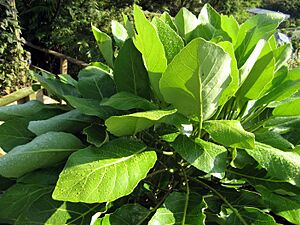Puka (tree) facts for kids
Quick facts for kids Puka |
|
|---|---|
| Conservation status | |
| Scientific classification | |
| Genus: |
Meryta
|
| Species: |
sinclairii
|
The puka, also called pukanui, is a special tree from New Zealand. It's an evergreen tree, which means it stays green all year round. This tree can grow up to 8 meters (about 26 feet) tall. It has a very tropical look, like trees you might see in warm places. There are about 27 different types of Meryta trees. They are all small, sticky trees found in warm parts of the Pacific Ocean.
Puka trees naturally grow on the Three Kings Islands and the Hen and Chicken Islands. They are found more often in sheltered valleys. These valleys have thick soil and are quite moist. Puka trees can also grow on cliffs with shallow, rocky soil. This shows they can handle dry conditions too.
Contents
What Does the Puka Tree Look Like?
The puka tree has large, thick, and leathery leaves. They can be up to 50 centimeters (20 inches) long and 20 centimeters (8 inches) wide. These are the biggest single leaves found on any plant in New Zealand. The stalks that hold the leaves can be up to 35 centimeters (14 inches) long. The leaves are shiny on top.
The tree grows green-white flowers. These flowers then turn into black berries. Many leaves grow close together at the ends of the branches.
How Puka Grows and Flowers
When a puka tree is young, it grows straight up. After it flowers for the first time, it starts to grow branches. It usually forms a round shape at the top.
Puka flowers are green-white and grow on tall stalks. These stalks can be up to 50 centimeters (20 inches) long. Flowers appear from spring through autumn. The flowers are not very noticeable. Only female puka trees produce fruit. Sometimes, a flower might have both male and female parts.
The fruit is round and black when it's ripe. It takes about a year for the fruit to grow. When the fruit starts to turn black, birds are attracted to it. The seeds inside are hard and dark.
Puka Tree Bark and Wood
The whole puka plant is a bit sticky. Its dark-brown bark has many small bumps. The bark can be easily damaged. When it heals, it forms large bumps. The wood of the puka tree is white and breaks easily. The branches are very strong. They show marks where old leaves have fallen off. The main trunk can be thick or thin. It has a few branches that grow in different directions.
How Puka Was Discovered
Europeans first learned about the puka tree from William Colenso. He found a single tree growing in Whangaruru Bay in Northland. This tree was protected by a fence. The Māori considered it sacred. They told Colenso they had brought the tree from the Poor Knights Islands.
Colenso visited Whangaruru Bay many times. He hoped to find flowers and fruit, but he never did. He showed the tree to Dr. Andrew Sinclair. Sinclair was a government official and a naturalist. The tree was later named after him. Colenso and Sinclair sent samples of the leaves to Kew Gardens in England.
Later, William Mair found the tree. He was able to get samples of the leaves and fruit. These were sent to Dr. Joseph Dalton Hooker at Kew. From these samples, the puka tree was first officially described. It was given the name Botryodendrum sinclairii.
Growing Puka Trees
In 1869, it was noted that puka trees were already being grown by people. Today, puka is a popular tree for streets and gardens in northern New Zealand. The best way to grow new puka trees is from seeds. You can also try growing them from cuttings, but it's harder.
Puka trees grow well in full sun or light shade. They don't like frost, especially when they are young. If the temperature drops below −2°C, the leaves can get damaged. However, puka has been grown as far south as Dunedin in protected spots.
Puka trees can handle strong winds. They are also not harmed by salt spray. This makes them great for growing near the coast. You can trim puka trees to keep them a certain size. They can also be grown in large pots. Young puka trees make good indoor plants.
There is a special type of puka called Meryta sinclairii var. 'Moonlight'. This type has attractive cream and yellow leaves. However, it doesn't grow as strongly or as easily as the wild puka tree.



